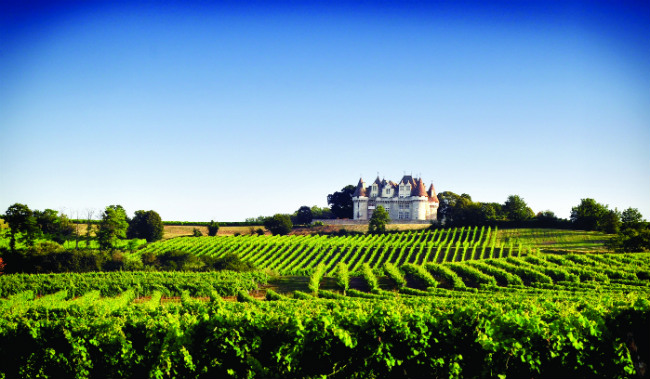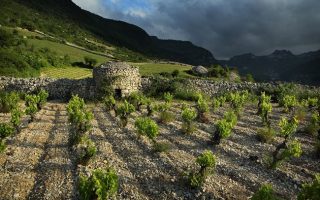Time with Wine: Monbazillac’s Golden Promise


As soon as you leave the suburbs of Bergerac you start to see rows and rows of leafy vines on a gently rising incline. This terrain faces north and rises to a summit, on which is the imposing Château de Monbazillac. Here you can spend a pleasant few hours visiting the château and discovering its under-rated wines, the AOC Monbazillac.
This special wine-growing area south of Bergerac in the Dordogne can trace its vinous roots back to the 11th century and the monks of the Abbaye Saint-Martin. The sweet wines produced here were enjoyed by locals until they had their own mini-renaissance in the 17th century when exiled Protestants took their love of the honey-coloured liquor back to Holland and spread the word. Yet for all that magnificent heritage, today the wine is still less widely known and tasted than it deserves.
In the 18th century, when Thomas Jefferson declared Château d’Yquem “the best French white wine” and placed a large order for himself and a certain Mr Washington, the presidential seal of approval was upon Sauternes, and having played second fiddle to its Médoc cousin can’t have helped Monbazillac. Both wines blend Semillon, Sauvignon and Muscadelle. Both wines benefit from autumn humidity with morning mists followed by warm sun, creating conditions for botrytis cinerea, the “noble rot” to work its magic.
It’s a challenge to cultivate these specialised wines in their small parcels of land, with the ripening process even more at the mercy of fickle climate changes than regular table wines. All these factors have tended to leave Monbazillac in the shadows as innovative southern hemisphere dessert wine producers expanded their market share. Most Monbazillac output is to the local market; restaurants in the Dordogne will often serve a glass to accompany an entrée of foie gras.
But things are starting to change. Great attention is being paid to quality control. Machine-harvesting was abandoned over a decade ago. Some winemakers have received attention in the media for their care and innovative approaches. There was a flurry of excitement when Robert Parker scored a 2003 Château Tirecul La Gravière at 95 points. Commenting on more recent vintages he said, “These are unreal values for such complex wines that can compete with the finest of Barsac and Sauternes at a fraction of the price.” That’s a strong message for buyers overseas.
And there was more good news from over the English Channel when popular TV chef Jamie Oliver visited the area: “Although these AOC wines are available widely in the UK, and the Château’s own are a little harder to find, believe me when I say they’re worth the search,” he commented.
There’s plenty of choice for your Monbazillac dégustation – explore the slopes and you’ll encounter Château Vari, Château de Malfourat, Château Les Sablines, among many others. Or visit Château Tirecul La Gravière, where Claudie and Bruno Bilancini continue with their labour of love to produce the very best Monbazillac.

courtesy of Château de Monbazillac
The Château de Monbazillac
But I’m heading for the imposing Château de Monbazillac itself, to visit the grand building and to taste the wines of the co-operative which owns the château and makes around 30 per cent of the region’s annual output. I want to find out why their recent Château de Monbazillac and Château Septy have been winning gold medals in France and on the international concourses. And as 2015 promises to be a star vintage due to extremely favourable climatic conditions, I figure this could be a good moment to stock up!
As a pre-dégustation taste-whetting exercise I recommend you take a quick tour of the château itself. The Grand Salon has a beautiful painted-beamed ceiling, a monumental Renaissance mantelpiece and a superb herringbone parquet floor of cherry, pine and oak. Down in the cellars and the vaulted kitchens is an interesting permanent exhibition explaining the history of the Monbazillac vineyards, together with numerous old wine-making tools and implements.
You can forget the sticky sweet wines you may have tasted before. These are lighter and more refined, with a pleasingly varied palate depending on the percentage of each grape variety used and the degree of maturation in barrels. It’s no surprise that the French will happily quaff these wines as an aperitif – they have a pleasing freshness with hints of citrus, apricot and subtle aromatic notes. Of the two award-winning wines, Château Monbazillac and Château Septy, it’s the Septy that I prefer – less heady and more of a flexible companion for pre- or post-dinner tipple or even with a Périgordine salad, whereas the Château Monbazillac has more of the unctuous depth required to accompany a mousse au chocolat, tarte tatin or crème brulée.
I had arrived too early for the 2015 release. Of course there’s no rush – these wines will keep for a good 30 years. But who can wait that long for a little taste of heaven?
Where to Buy
From the US: www.wine-searcher.com/find/monbazillac/1/usa
From the UK: www.wine-searcher.com/find/monbazillac/1/uk
From France Today magazine
Want to visit The Dordogne? Join France Today on one of our luxury tours of Darling Dordogne
Share to: Facebook Twitter LinkedIn Email
By Guy Hibbert
Leave a reply
Your email address will not be published. Required fields are marked *



